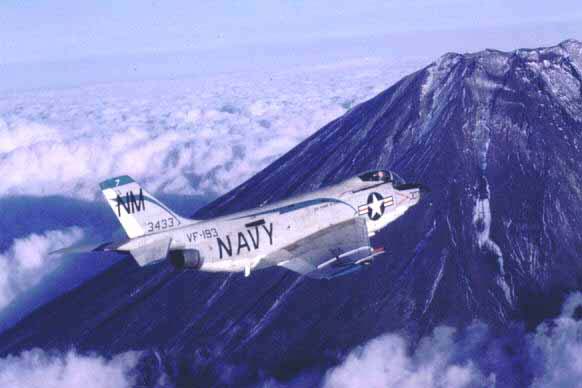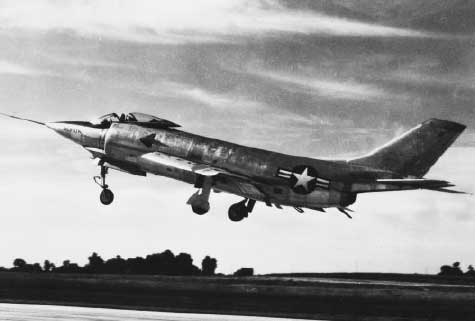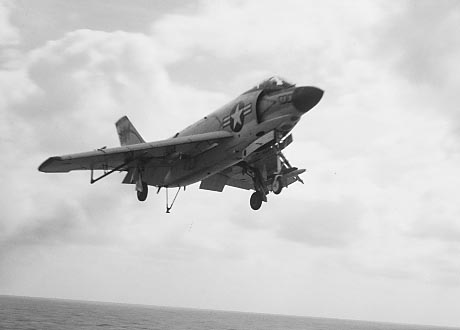The
McDonnell F3H Demon

VF-193 Demon over
Mount Fuji, flown by LtJg Clint Smith
In 1949,
the Navy awarded the McDonnell Company a contract to produce a carrier-based, jet powered,
all-weather interceptor designed as a successor to the F2H Banshee and incorporating the
latest technology addressing the questions about jet-powered carrier-based tactical
planes. The F3H was to be powered by Navy's newest, jet engine, the Westinghouse J-40. The
J-40 was promised by Westinghouse to have about twice the thrust of engines then in Navy
service (10 to 11,000 lbs. of thrust in military, and 15,000 lbs. in afterburner)

XF3H-1: The
experimental version of the Demon.
THE F3H-1
60 J-40 engined F3H-l's were built - of those 25
never flew and two were converted to F3H-2 prototypes. Of those that flew, 8 were involved
in major accidents, three of which were due directly to engine failures. By the time
construction of the J-40 engined Demons was stopped, $289 million had been spent, of which
$107 million went to Westinghouse for the J-40 engine disaster. Westinghouse, for good
reason, soon quit the engine business.
The first flight of the production version of the J-40 engined Demon was in January 1953.
During flight testing the engine proved to be inadequate so the Navy decided to equip the
61st and subsequent F3H's with the Allison J-71.
FLIGHT TESTING THE F3H-1
The J-40 powered F3H-l flight test program was described as "sort of a
joke," because everyone knew that it would have to be re-engined and that the Navy
would never use it. The J-40 engine proved unreliable in every respect but, because of the
pressures of the Korean War, aircraft production progressed during prototype testing.
Because of the engine failures all J-40 powered Demon's were grounded. Amazingly, 25 brand
new Demons were shipped to Naval Air Training Centers, where they were used as training
aids. Changes were made in the second batch of thirty that allowed them to be fitted with
the J-71; it would have been too expensive to bring the first up to J-71 standards.
With the exception of the A3 (which did not require a bifurcated intake duct), the
Westinghouse engine failures ruined an entire generation of Naval aircraft. Both the F7U
"Cutlass" and F3H were aircraft potentially competitive with the Air Force's
Century Series fighters, had their original engines performed up to design specifications.
The combination of delayed deliveries, and the degraded performance caused by major engine
changes in an established airframe design rendered the F3H Demons relatively ineffectual
when they finally reached the fleet.

VF-193 Demon on
final approach
In this photo the Demon is carrying a
Delmar target boom mounted on the outboard missile pylon and its air driven winch mounted
on the inboard missle pylon. This rig enable the pilot to reel out (and in) a finned
target made of lightweight plastic which could be trailed on a 5 mile length of piano
wire. The target had flares that could be ignited by radio signals to provide a homing
heat source for Sidewinder missiles and a radar reflector which provided a target for
Sparrow missiles. For Sparrow missile shots the firing aircraft approached the target from
the front, receiving a "cleared to fire" from the ground controllers when it
passed the tow plane.
Next Page...
© 2005 by Bob Jellison
Wednesday, March 23, 2005
www.carrierbuilders.net |


